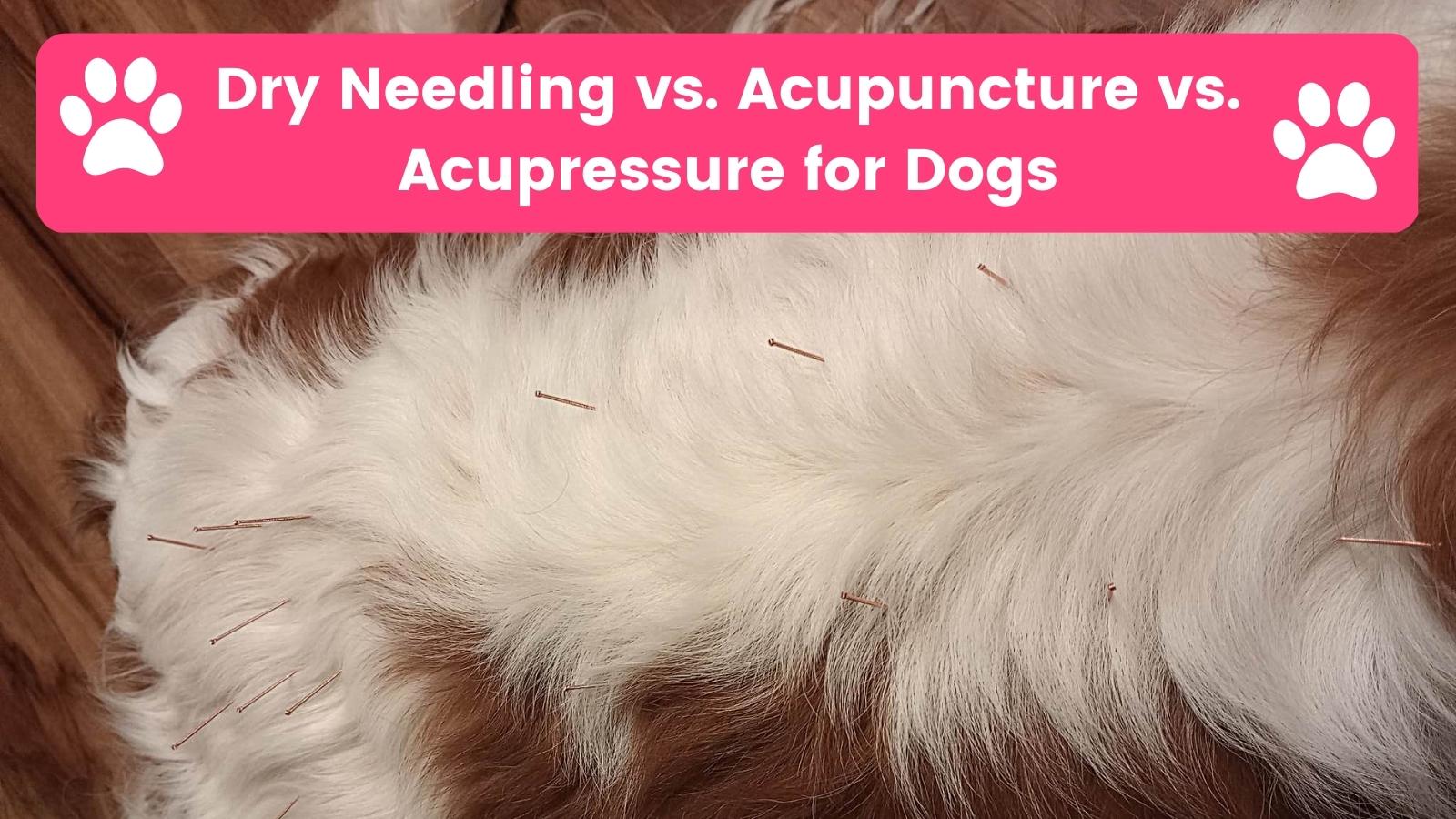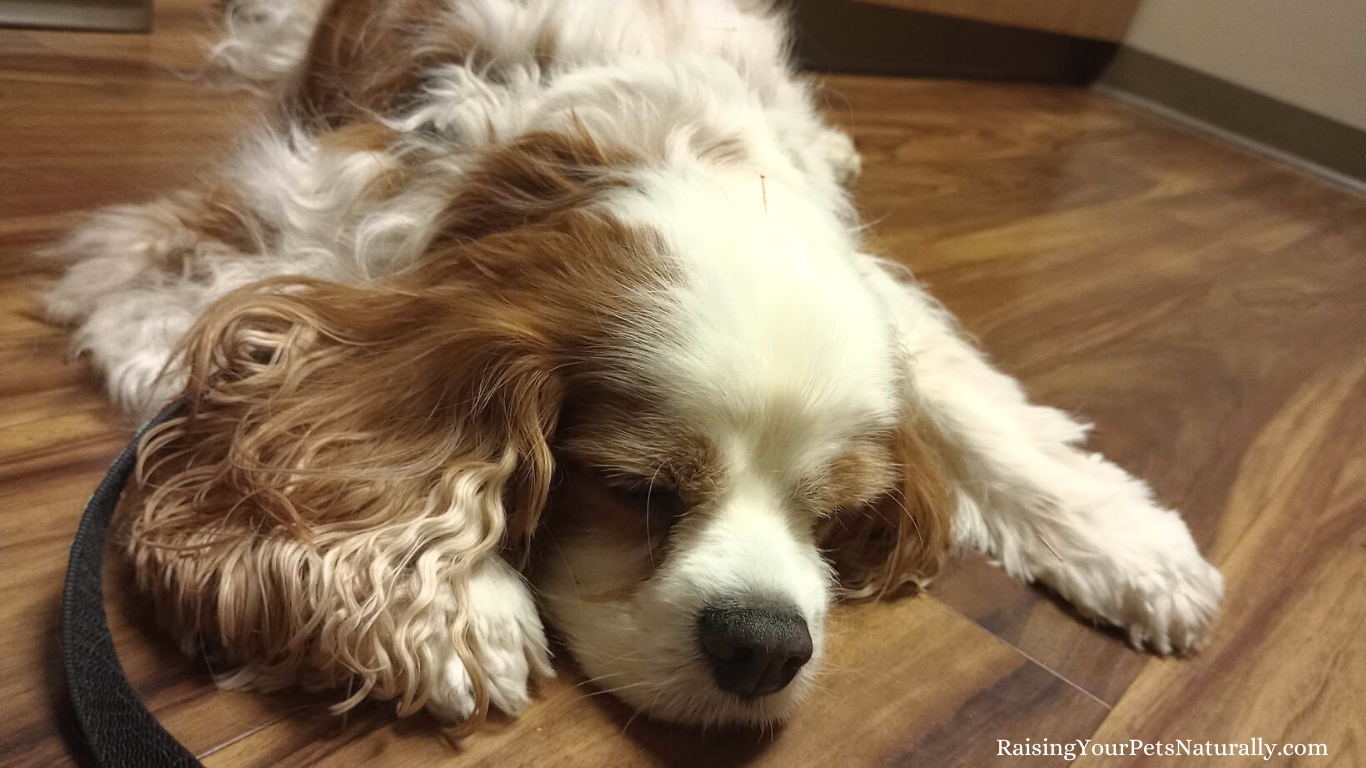Dry Needling vs. Acupuncture vs. Acupressure for Dogs

My now thirteen-year-young Cavalier King Charles Spaniel just started dry needling with his practitioner. For those new to the blog, Dexter was diagnosed with Chiari Malformation and syringomyelia just before his 3rd birthday. Over the course of his life, he has had various natural treatments such as food therapy, laser therapy, acupuncture, canine rehabilitation, PEMF treatments, and some pharmaceuticals.
Watch some of Dexter’s rehab and don’t forget to subscribe for more content.
This month, he started dry needing, so I thought it would be a good time to dive into the difference between dry needling, acupuncture, and acupressure for dogs and how these treatments can be used with Dexter’s overall treatment plan. But I can’t do this alone, so I spoke to various experts in the field, and this is what they had to say.
Benefits of Dry Needling, Acupuncture, and Acupressure for Dogs and Pets
Alex Schechter, DVM, founder of Burrwood Veterinary, offered these insights: “The benefits of dry needling, acupuncture, and acupressure are numerous and can include pain relief, improved circulation, and relaxation.” Dr. Schechter also offered these insights to the various treatments: “When deciding which modality to use, it is essential to consider the pet’s individual needs. For example, dry needling may be more beneficial for pets with chronic pain, while acupuncture may be more beneficial for pets with digestive issues. Acupressure may be more useful for pets with anxiety or stress.”
I also spoke with Michelle Lehr, CCMT ( Therapist certification through Brandenburg Massage Therapy), and she stated, “All three of these treatments can be beneficial for dogs, although the efficacy of each treatment depends on the condition being addressed. In general, dry needling is often the best option for treating musculoskeletal conditions such as arthritis, while acupuncture is best for conditions related to the flow of energy. Acupressure can be used to address both musculoskeletal and energy-related issues. However, the best treatment for each dog will depend on the condition, the dog’s response to the treatment, and overall health.”
Acupressure for Dogs and Pets
Michelle explained how acupressure can be used with dogs. She said, “Acupressure is a type of massage therapy that involves applying pressure to specific points throughout the body to reduce pain and promote relaxation. This method works by stimulating the circulation of energy, or chi, and can be beneficial in treating a variety of conditions. Acupressure can also be used in conjunction with massage and other forms of therapy.”
At this time, since Dexter’s disease makes his body a bit sensitive to touch, I have not implemented acupressure. However, I do some specific canine stretches and some massage, paying close attention to how he responds.
Watch some of Dexter’s stretching. Don’t forget to subscribe for more free content.
Acupuncture for Dogs and Pets
One of the first natural treatments Dexter received for his Chiari Malformation and syringomyelia was acupuncture with Mary L. Cardeccia, DVM, CVA, CVFT, CCRT, CCMT, owner of Animal Rehabilitation Facility.
I asked Dr. Schechter about acupuncture and the ins and outs of the treatment. He explained, “Acupuncture is a traditional Chinese medicine form that uses thin needles to stimulate particular points on the body to balance energy flow.”
Samantha Amodeo D.C., CCRP, explains that ” Each acupuncture point has specific actions when stimulated. This technique has been used in veterinary practice in China for thousands of years to treat many ailments. Acupuncture is used all around the world, either along with or in conjunction with Western medicine, to treat a wide variety of conditions in every species of animal. Clinical research has been conducted showing positive results in the treatment of both animals and humans, and the use of acupuncture is increasing. Acupuncture will not cure every condition, but it can work very well when it is indicated.”
Watch one of Dexter’s Acupuncture Sessions.
Dry Needling for Dogs and Pets
Dexter’s dry needling treatments just started in January 2023, so I was really interested to learn more about this process. I asked Michelle about the process, and she offered this insight, “Dry needling treatment is most often used to treat musculoskeletal conditions, such as arthritis, and can help reduce inflammation and pain. It can be used as a standalone treatment or in conjunction with other therapies.”
Of course, I wanted to follow up on this question with Dexter’s practitioner, Samantha Amodeo D.C., CCRP. I asked her about the technique she is using with Dexter and his specific treatment plan. She explained, “Trigger point dry needling is a technique to help decrease your pet’s myofascial pain caused by trigger points resulting in muscle spasms and dysfunction. We use a sterile needle into the muscle belly and help release the trigger point. The technique we like to use in clinic is called the ‘pulsing’ technique which will give small contractions to the muscle to help relieve pain and eliminate the trigger point. A trigger point is essentially a knotted muscle; when the animal has knotted muscles, they cannot function properly and also causes pain.”
She continued by saying, “The most common trigger points we are finding in Dexter are throughout his triceps and infraspinatus muscles due to compensation issues. We find most trigger points due to compensation issues with front end or hind end lameness. Other trigger points are commonly found in the hamstring and quadricep muscle groups as well as the iliopsoas muscle. Canine dry needling can eliminate neuromuscular dysfunction that leads to pain and functional deficits.”
This made a lot of sense since Dexter’s dry needling is focusing on the points of his body that are physically tight and tender vs. his acupuncture where the needles are placed to address energy flow. They both are addressing his condition, but different needs.

How to Find a Qualified Canine Practitioner
Dr. Schechter suggested, “When looking for a qualified practitioner, it is essential to check their credentials and experience. It is also vital to ensure that the practitioner is familiar with pets’ needs and has experience working with them. Additionally, it is crucial to ensure that the practitioner is licensed and insured. Finally, it is vital to ask for references from previous clients and to read reviews online.”
Michele also offered these tips: “Ask a few key questions in order to ensure the best match is made. It is beneficial to inquire about the experience level, credentials, and specialty services offered. Are the services provided consistent with the specific needs of the pet? Is the practitioner familiar with the pet’s particular breed or medical history?”
Dexter’s Personal Experiences
I am happy to report that the addition of dry needling for Dexter has been successful. His triceps have been improving and have been less sensitive. Remember, Dexter’s dry needling is in conjunction with weekly canine rehabilitation, acupuncture, at-home exercises, and so much more. Canine care is a synergy effect.
If your pet is experiencing discomfort or mobility issues, I definitely recommend looking into alternative natural treatments such as the ones we discussed.
Thank you to all of the wonderful practitioners who assisted me in today’s blog post. Dexter and I truly appreciate what all of you are doing to assist the canine community.
Websites to help find a practitioner.
- https://alumni.chiu.edu/
- https://www.caninerehabinstitute.com/Find_A_Therapist.html
- https://www.ncsuvetce.com/canine-rehab-ccrp/ccrp-practitioners/
Your questions or comments are welcome below.
Are you looking for even more ways to stay up to date with Raising Your Pets Naturally? Sign up for the newsletter for more tips and promotions. Don’t forget to be social and Like, Follow and Subscribe.
Facebook Twitter Pinterest Instagram YouTube
 |
 |

Google Adsense—>




